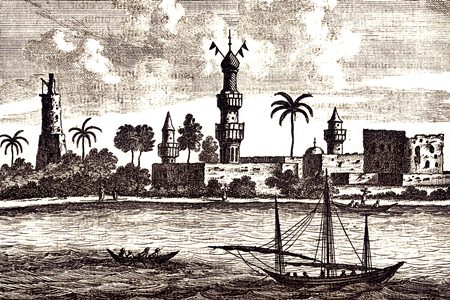
Raid on Damietta |
year: 85322 May 853 |
| The Byzantines plundered the city and left | ★ ★ ★ ★ ★ |
|
enemy: Arabs (Abbasids)
|
location: Damietta or Domyat, in Egypt, at the intersection between the Mediterranean Sea and the Nile, about 200 kilometres north of Cairo
|
accuracy:
●●●●●
|
|
battle type: City Capture |
war: Byzantine-Muslim Wars |
modern country:
Egypt |
| ▼ The Byzantines(emperor: Theodora) | ▼ The Enemies | |
| Commander: | Damianos, (Ibn Qatuna by Arabs) | Anbasa ibn Ishaq al-Dabbi (absent) |
| Forces: | 85 ships, 5,000 men | The garrison was absent |
| Losses: |
| Background story: |
| Byzantium had lost Egypt to the Arabs in the 640s. After two centuries of war, during the 820s, the Byzantines had suffered two great losses that destroyed their naval supremacy in the Mediterranean: the beginning of the Muslim conquest of Sicily and the fall of Crete to Andalusian Arab exiles. These losses ushered an era where Saracen pirates raided the Christian northern shores of the Mediterranean almost at will. Several Byzantine attempts to retake Crete in the immediate aftermath of the Andalusian conquest had failed disastrously. In 852/853, the Byzantine government tried a new approach: it assembled a huge naval armament, of 3 fleets consisting of 300 ships, and sent them to raid Muslim naval bases in the Mediterranean simultaneously. At the time, The Byzantine Empire was ruled by Theodora as regent for her minor son Michael III. She was good. Among other initiatives, she organized military operations against the Arabs on multiple fronts. One of these fronts was Egypt, because it was from there that the Abbasids sent aid to Crete. |
The Battle: |
 The port of Damietta in 1714, Cornelis de Bruyn One must assume that the Greeks were very well informed. The Arab governor Anbas had invited the city garrison of Damietta to attend a festival in the far away inland city of Fustat (Cairo) at the exact moment the Greek fleet arrived. So, the garrison was absent, and the inhabitants fled when the Byzantines arrived. The city was plundered for two days and then torched. The Byzantines carried of some 600 Arab and Coptic women, as well as large quantities of arms and other supplies intended for Crete. The fleet then sailed eastward down the coast to the island of Tinnis. Fearing sandbanks, the fleet moved on to the fortress of Ushtum. The fortress was strongly walled with iron gates. The Byzantines did not want to engage in a major siege operation so far into enemy territory. So they destroyed what war engines they found outside the city walls and then sailed for home. |
Noteworthy: |
| Although a rare success, the raid is completely ignored in Byzantine sources, whose accounts are warped by their hostile attitude to Michael III and his reign. Consequently the raid is known only through two Arab accounts. |
Aftermath: |
| The raid was a rare success for the Greeks of Byzantium and a shock for the Arabs. The realization of Egypt’s vulnerability from the sea sparked an urgent effort to strengthen its maritime defenses. This marked the rebirth of the Egyptian navy. |
|
|
